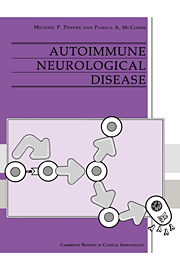Book contents
- Frontmatter
- Contents
- Preface
- 1 Antigen recognition and self–non-self discrimination
- 2 An introduction to neuroimmunology
- 3 Experimental autoimmune encephalomyelitis
- 4 Multiple sclerosis
- 5 Acute disseminated encephalomyelitis
- 6 The stiff-man syndrome
- 7 Experimental autoimmune neuritis
- 8 The Guillain–Barré syndrome and acute dysautonomia
- 9 Chronic immune-mediated neuropathies
- 10 Autoimmune diseases of the neuromuscular junction and other disorders of the motor unit
- 11 Inflammatory myopathies and experimental autoimmune myositis
- 12 Paraneoplastic neurological disorders
- 13 Neurological complications of connective tissue diseases and vasculitis
- Index
8 - The Guillain–Barré syndrome and acute dysautonomia
Published online by Cambridge University Press: 22 September 2009
- Frontmatter
- Contents
- Preface
- 1 Antigen recognition and self–non-self discrimination
- 2 An introduction to neuroimmunology
- 3 Experimental autoimmune encephalomyelitis
- 4 Multiple sclerosis
- 5 Acute disseminated encephalomyelitis
- 6 The stiff-man syndrome
- 7 Experimental autoimmune neuritis
- 8 The Guillain–Barré syndrome and acute dysautonomia
- 9 Chronic immune-mediated neuropathies
- 10 Autoimmune diseases of the neuromuscular junction and other disorders of the motor unit
- 11 Inflammatory myopathies and experimental autoimmune myositis
- 12 Paraneoplastic neurological disorders
- 13 Neurological complications of connective tissue diseases and vasculitis
- Index
Summary
The Guillain–Barré syndrome
Introduction
Guillain, Barré & Strohl (1916) described a syndrome of ascending weakness, associated with loss of deep tendon reflexes and early recovery, in two soldiers. During the same period, others reported rather similar patients with acute febrile polyneuritis and acute infective polyneuritis (Holmes, 1917; Bradford, Bashford & Wilson, 1918). Earlier, Landry (1859) had described a patient who died in respiratory failure after developing ascending weakness. As noted by Cosnett (1987), Wardrop (1834) had also reported a patient with an episode of weakness with spontaneous recovery. In 1949, Haymaker & Kernohan analysed the published reports and established the modern use of the term ‘the Guillain–Barré syndrome’ (GBS). Histories of the syndrome have been written by Horowitz (1989), Wiederholt, Mulder & Lambert (1964) and Asbury (1990). Guillain (1936) also reviewed the syndrome in 1936, 20 years after his original description. GBS is also known as acute inflammatory demyelinating polyradiculoneuropathy, which is a term that reflects the pathological features of the disease. There is increasing evidence that GBS is an autoimmune disease: some of this evidence comes from the finding of similarities between GBS and experimental autoimmune encephalomyelitis (EAN) (see Chapter 7).
Clinical features
Clinical symptoms and signs
Guillain (1936) described the clinical features of the GBS.
- Type
- Chapter
- Information
- Autoimmune Neurological Disease , pp. 202 - 228Publisher: Cambridge University PressPrint publication year: 1995

